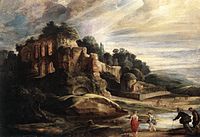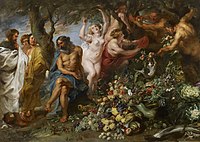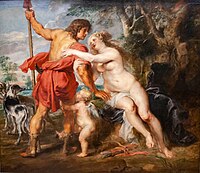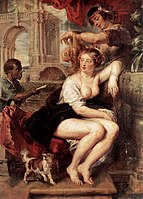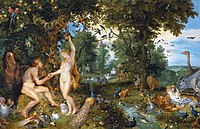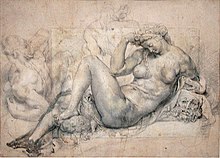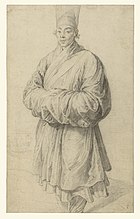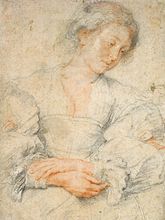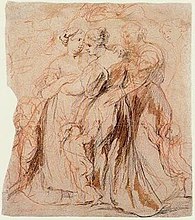Peter Paul Rubens
Peter Paul Rubens | |
|---|---|
 Self-Portrait, 1623, Royal Collection | |
| Born | 28 June 1577 |
| Died | 30 May 1640 (aged 62) |
| Nationality | Flemish |
| Education | Tobias Verhaecht Adam van Noort Otto van Veen |
| Known for | Painting, drawing, tapestry design, print design |
| Movement | Flemish Baroque |
| Spouses | |
| Children | 8, including Nikolaas and Albert |
| Parents |
|
| Signature | |
 | |
Sir Peter Paul Rubens (/ˈruːbənz/ ROO-bənz,[1] Dutch: [ˈrybə(n)s]; 28 June 1577 – 30 May 1640) was a Flemish artist and diplomat.[2] He is considered the most influential artist of the Flemish Baroque tradition. Rubens's highly charged compositions reference erudite aspects of classical and Christian history. His unique and immensely popular Baroque style emphasized movement, colour, and sensuality, which followed the immediate, dramatic artistic style promoted in the Counter-Reformation. Rubens was a painter producing altarpieces, portraits, landscapes, and history paintings of mythological and allegorical subjects. He was also a prolific designer of cartoons for the Flemish tapestry workshops and of frontispieces for the publishers in Antwerp.
He was born and raised in Germany, to parents who were refugees from
His commissioned works were mostly
He was one of the last major artists to make consistent use of wooden panels as a support medium, even for very large works, but he used canvas as well, especially when the work needed to be sent a long distance. For altarpieces he sometimes painted on slate to reduce reflection problems.
Life
Early life
Rubens was born in
Jan Rubens became the legal adviser of Anna of Saxony, the second wife of William I of Orange, and resided at her court in Siegen in 1570. He subsequently had an affair with her, which led to a pregnancy.[6] Jan Rubens was imprisoned in Dillenburg Castle and was at risk of being sentenced to death for his offence. The illegitimate daughter, Christina of Dietz, was born on 22 August 1571.[7]
Thanks to the pleas of his wife, Jan Rubens was able to leave prison after two years. After his release, Jan Rubens was forbidden to practice his profession as a lawyer for some time and had to settle in Siegen under supervision. This put a heavy strain on the family, which was relieved only when in 1577, following the death of Anna of Saxony, the professional ban imposed against Jan Rubens was lifted. Into this difficult situation Philip Rubens was born in 1574, followed in 1577 by his brother Peter Paul who was baptised in Cologne at St Peter's Church. When in 1578 Jan Rubens was allowed to leave his place of exile Siegen, he moved the Rubens family moved to Cologne, where father Jan died in 1587.[7]
In Siegen, the family had of necessity belonged to the Lutheran Church. In Cologne, the family reverted to Catholicism.[8] The eldest son, Jan Baptist, who may also have been an artist, left for Italy in 1586. The widow Maria Pypelinckx returned with the rest of the family (i.e. Blandina, Philip and Peter Paul) to Antwerp in 1590, where they moved into a house on the Kloosterstraat.[7]
Apprenticeship

Until his death in 1587, father Jan was personally involved in his sons' education. Peter Paul and his older brother Philip Rubens received a
Italy (1600–1608)
In 1600 Rubens traveled to Italy. He stopped first in
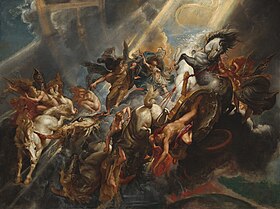
Rubens later made a copy of Caravaggio's Entombment of Christ and recommended his patron, the Duke of Mantua, to buy The Death of the Virgin (Louvre).[14] After his return to Antwerp he was instrumental in the acquisition of The Madonna of the Rosary (Kunsthistorisches Museum, Vienna) for the St. Paul's Church in Antwerp.[15] During this first stay in Rome, Rubens completed his first altarpiece commission, St. Helena with the True Cross for the Roman church of Santa Croce in Gerusalemme.
Rubens travelled to Spain on a diplomatic mission in 1603, delivering gifts from the Gonzagas to the court of Philip III.[16] While there, he studied the extensive collections of Raphael and Titian that had been collected by Philip II.[17] He also painted an equestrian portrait of the Duke of Lerma during his stay (Prado, Madrid) that demonstrates the influence of works like Titian's Charles V at Mühlberg (1548; Prado, Madrid). This journey marked the first of many during his career that combined art and diplomacy.
He returned to Italy in 1604, where he remained for the next four years, first in Mantua and then in Genoa. In Genoa, Rubens painted numerous portraits, such as the Marchesa Brigida Spinola-Doria (National Gallery of Art, Washington, D.C.), and the portrait of Maria di Antonio Serra Pallavicini, in a style that influenced later paintings by Anthony van Dyck, Joshua Reynolds and Thomas Gainsborough.[18] He made drawings of the many new palaces that were going up in Genoa. These were later engraved and published in 1622 as Palazzi di Genova.
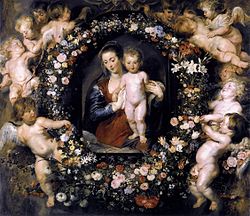
From 1606 to 1608, he was mostly in Rome when he received, with the assistance of Cardinal
Rubens's experiences in Italy continued to influence his work. He continued to write many of his letters and correspondences in Italian, signed his name as "Pietro Paolo Rubens", and spoke longingly of returning to the peninsula—a hope that never materialized.[21]
Antwerp (1609–1621)
Upon hearing of his mother's illness in 1608, Rubens planned his departure from Italy for Antwerp. However, she died before he arrived home. His return coincided with a period of renewed prosperity in the city with the signing of the
He received special permission to base his studio in Antwerp instead of at their court in Brussels, and to also work for other clients. He remained close to the Archduchess Isabella until her death in 1633, and was called upon not only as a painter but also as an ambassador and diplomat. Rubens further cemented his ties to the city when, on 3 October 1609, he married Isabella Brant, the daughter of a leading Antwerp citizen and humanist, Jan Brant.
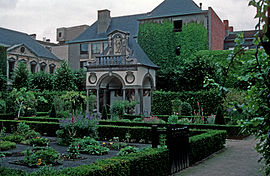
In 1610, Rubens moved into a new house and studio that he designed. Now the Rubenshuis Museum, the Italian-influenced villa in the centre of Antwerp accommodated his workshop, where he and his apprentices made most of the paintings, and his personal art collection and library, both among the most extensive in Antwerp. During this time he built up a studio with numerous students and assistants. His most famous pupil was the young Anthony van Dyck, who soon became the leading Flemish portraitist and collaborated frequently with Rubens. He also often collaborated with the many specialists active in the city, including the animal painter Frans Snyders, who contributed the eagle to Prometheus Bound (c. 1611–12, completed by 1618), and his good friend the flower-painter Jan Brueghel the Elder.
Another house was built by Rubens to the north of Antwerp in the polder village of Doel, "Hooghuis" (1613/1643), perhaps as an investment. The "High House" was built next to the village church.

Altarpieces such as
Rubens used the production of

Marie de' Medici Cycle and diplomatic missions (1621–1630)
In 1621, the Queen Mother of France,

After the end of the Twelve Years' Truce in 1621, the Spanish
At the courts he sometimes encountered the attitude that courtiers should not use their hands in any art or trade, but he was also received as a gentleman by many. Rubens was raised by Philip IV of Spain to the nobility in 1624 and knighted by Charles I of England in 1630. Philip IV confirmed Rubens's status as a knight a few months later.
Rubens was in Madrid for eight months in 1628–1629. In addition to diplomatic negotiations, he executed several important works for Philip IV and private patrons. He also began a renewed study of Titian's paintings, copying numerous works including the Madrid Fall of Man (1628–29).[32] During this stay, he befriended the court painter Diego Velázquez and the two planned to travel to Italy together the following year. Rubens, however, returned to Antwerp and Velázquez made the journey without him.[33]

His stay in Antwerp was brief, and he soon travelled on to London where he remained until April 1630. An important work from this period is the Allegory of Peace and War (1629;
While Rubens's international reputation with collectors and nobility abroad continued to grow during this decade, he and his workshop also continued to paint monumental paintings for local patrons in Antwerp. The Assumption of the Virgin Mary (1625–26) for the Cathedral of Antwerp is one prominent example.
Last decade (1630–1640)
Rubens's last decade was spent in and around Antwerp. Major works for foreign patrons still occupied him, such as the ceiling paintings for the

In 1630, four years after the death of his first wife Isabella, the 53-year-old painter married his first wife's niece, the 16-year-old
In 1635, Rubens bought an estate outside Antwerp, the
Death

Rubens died from heart failure as a result of his chronic
At the request of
Work
His biblical and mythological nudes are especially well-known. Painted in the Baroque tradition of depicting women as soft-bodied, passive, and to the modern eye highly sexualized beings, his nudes emphasize the concepts of fertility, desire, physical beauty, temptation, and virtue. Skillfully rendered, these paintings of nude women are thought by feminists to have been created to sexually appeal to his largely male audience of patrons,[38] although the female nude as an example of beauty has been a traditional motif in European art for centuries. Additionally, Rubens was quite fond of painting full-figured women, giving rise to terms like 'Rubensian' or 'Rubenesque' (sometimes 'Rubensesque'). His large-scale cycle representing Marie de' Medici focuses on several classic female archetypes like the virgin, consort, wife, widow, and diplomatic regent.[39] The inclusion of this iconography in his female portraits, along with his art depicting noblewomen of the day, serve to elevate his female portrait sitters to the status and importance of his male portrait sitters.[39]

Rubens's depiction of males is equally stylized, replete with meaning, and quite the opposite of his female subjects. His male nudes represent highly athletic and large mythical or biblical men. Unlike his female nudes, most of his male nudes are depicted partially nude, with sashes, armour, or shadows shielding them from being completely unclothed. These men are twisting, reaching, bending, and grasping: all of which portrays his male subjects engaged in a great deal of physical, sometimes aggressive, action. The concepts Rubens artistically represents illustrate the male as powerful, capable, forceful and compelling. The allegorical and symbolic subjects he painted reference the classic masculine tropes of athleticism, high achievement, valour in war, and civil authority.[40] Male archetypes readily found in Rubens's paintings include the hero, husband, father, civic leader, king, and the battle weary.
Rubens was a great admirer of Leonardo da Vinci's work. Using an engraving done 50 years after Leonardo started his project on the Battle of Anghiari, Rubens did a masterly drawing of the Battle which is now in the Louvre in Paris. "The idea that an ancient copy of a lost artwork can be as important as the original is familiar to scholars", says Salvatore Settis, archaeologist and art historian.[41]
Workshop

Paintings from Rubens's workshop can be divided into three categories: those he painted by himself, those he painted in part (mainly hands and faces), and copies supervised from his drawings or
He also often sub-contracted elements such as animals, landscapes or
Art market
At a
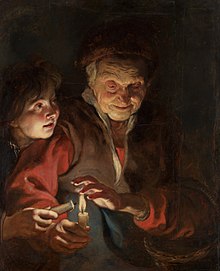
Selected exhibitions
- 1936: Rubens and His Times, Paris.
- 1997: The Century of Rubens in French Collections, Paris.
- 2004: Rubens, Palais de Beaux-Arts, Lille.
- 2005: Peter Paul Rubens: The Drawings, Metropolitan Museum of Art, New York.
- 2015: Rubens and His Legacy, The Royal Academy, London.
- 2017: Rubens: The Power of Transformation, Kunsthistorisches Museum, Vienna.
- 2019: Early Rubens, Art Gallery of Ontario Toronto, Fine Arts Museums of San Francisco.[44]
Lost works
Lost works by Rubens include:
- The Crucifixion, painted for the Church of Santa Croce in Gerusalemme, Rome, was imported to England in 1811. It was auctioned in 1812 and again in 1820 and 1821 but was lost at sea sometime after 1821.[45]
- Equestrian Portrait of the Archduke Albert
- Susannah and the Elders is now known only from engraving from 1620 by Lucas Vosterman.
- Satyr, Nymph, Putti and Leopards is now known only from engraving.
- Judith Beheading Holofernes c. 1609 known only through the 1610 engraving by Cornelis Galle the Elder.
- Works destroyed in the bombardment of Brusselsinclude:

- Madonna of the Rosary painted for the Royal Chapel of the Dominican Church
- Virgin Adorned with Flowers by Saint Anne, 1610 painted for the Church of the Carmelite Friars
- Saint Job Triptych, 1613, painted for Saint Nicholas Church
- Cambyses Appointing Otanes Judge, Judgment of Solomon, and Last Judgment, all for the Magistrates' Hall
- In the Coudenberg Palace fire there were several works by Rubens destroyed, like Nativity (1731), Adoration of the Magi and Pentecost.[46]
- The paintings Neptune and Amphitrite, Vision of Saint Hubert and Diana and Nymphs Surprised by Satyrs was destroyed in the Friedrichshain flak tower fire in 1945.[47]
- The painting The Abduction of Proserpine was destroyed in the fire at Blenheim Palace, Oxfordshire, 5 February 1861.[48]
- The painting Crucifixion with Mary, St. John, Magdalen, 1643 was destroyed in the English Civil War by Parliamentarians in the Queen's Chapel, Somerset House, London, 1643[49]
- The painting Equestrian Portrait of Philip IV of Spain was destroyed in the fire at Royal Alcázar of Madrid firein 1734. A copy is in the Uffizi Gallery.
- The Continence of Scipio was destroyed in a fire in the Western Exchange, Old Bond Street, London, March 1836[50]
- The painting The Lion Hunt was removed by Napoleon's agents from Schloss Schleissheim, near Munich, 1800 and was destroyed later in a fire at the Musée des Beaux-Arts de Bordeaux.[51]
- An alleged Rubens painting Portrait of a Girl reported to have been in the collection of Alexander Dumas was reported lost in a fire.[52]
- The painting Equestrian Portrait of the Duke of Buckingham (1625) and the ceiling painting The Duke of Buckingham Triumphing over Envy and Anger (c. 1625), both later owned by the Earl of Jersey at Osterley Park, were destroyed in a fire at the Le Gallais depository in St Helier, Jersey, on 30 September 1949.[53]
- Portrait of Philip IV of Spain from 1628 was destroyed in the incendiary attack at the Kunsthaus Zürich in 1985.[54]
- Portrait of George Villiers, c. 1625. This painting that had been deemed lost for nearly 400 years was rediscovered in 2017 in Pollok House, Glasgow, Scotland. Conservation treatment carried out by Simon Rollo Gillespie helped to demonstrate that the work was not a later copy by a lesser artist but was the original by the hand of the master himself.[55][56][57]
Works
Main article: List of paintings by Peter Paul Rubens
- Early paintings
-
Equestrian portrait of the Duke of Lerma, 1603, Prado Museum
-
The Judgement of Paris, c. 1606, Museo del Prado
-
Portrait of a Young Woman with a Rosary, 1609–10, oil on wood, Thyssen-Bornemisza Museum
-
Venus with a Mirror (after Titian), c. 1606–1611
-
Venus at the Mirror, 1613–14
-
Diana Returning from Hunt, 1615, oil on canvas, Gemäldegalerie Alte Meister
- Historical portraits
-
Portrait of Marchesa Brigida Spinola-Doria, 1606
-
Portrait of King Philip IV of Spain, c. 1628–29
-
Portrait of Elisabeth of France, 1628, Kunsthistorisches Museum, Vienna
-
Portrait of Ambrogio Spinola, c. 1627, National Gallery in Prague
-
Sketch for Equestrian Portrait of George Villiers, 1st Duke of Buckingham, 1625, Kimbell Art Museum
-
Portrait of King Władysław IV Vasa of Poland, 1620s, Wawel Royal Castle National Art Collection
- Landscapes
-
Landscape with the Ruins of Mount Palatine in Rome, 1615
-
Miracle of Saint Hubert, painted together with Jan Bruegel, 1617
-
Landscape with Milkmaids and Cattle, 1618
-
National Gallery, London
- Mythological
-
Jupiter and Callisto, 1613, Museumslandschaft of Hesse in Kassel
-
Pythagoras Advocating Vegetarianism, 1618–1630, by Rubens and Frans Snyders, inspired by Pythagoras's speech in Ovid's Metamorphoses, Royal Collection
-
Perseus and Andromeda, c. 1622, Hermitage Museum
-
Ermit and sleeping Angelica, 1628
-
Perseus Liberating Andromeda, 1639–40, Museo del Prado
-
Minerva Protecting Peace from Mars, 1629–1630, The National Gallery, London
-
Bacchanalia scene with nymphs and satyrs (detail of The feast of Venus Verticordia, 1635–36), Kunsthistorisches Museum in Vienna
-
The Three Graces, 1635,Prado
-
Diana and her Nymphs surprised by the Fauns, c. 1639–40, Prado Museum
-
Venus and Adonis, 1635–1638, Metropolitan Museum of Art
-
The Birth of the Milky Way, c. 1637, Prado Museum
- Helena Fourment and related pictures
-
Rubens with Hélène Fourment and their Son Peter Paul, 1639, Metropolitan Museum of Art
-
Bathsheba at the Fountain, 1635
-
Pastoral Scene, 1636
- Biblical Scenes
-
Jan Brueghel the Elder and Peter Paul Rubens, The Garden of Eden with the Fall of Man, Mauritshuis, The Hague
-
Lot and His Daughters, c. 1613–14
-
The Holy Trinity, Kunstmuseum Basel
-
The Annunciation, 1609, Kunsthistorisches Museum
- Drawings
-
The Night, 1601–1603, black chalk and gouache on paper (after Michelangelo), Louvre-Lens
-
Possibly Rubens' daughter Clara Serena, c. 1623
-
Young Woman with Folded Hands, c. 1629–30, red and black chalk, heightened with white, Boijmans Van Beuningen
-
Study of Three Women (Psyche and her sisters), c. 1635,Warsaw University Library
-
Study for a St. Mary Magdalen, date unknown, British Museum
Notes
- ^ "Rubens". Random House Webster's Unabridged Dictionary.
- ISBN 978 90 8964 027 7.
- ^ Nico Van Hout, Functies van doodverf met bijzondere aandacht voor de onderschildering en andere onderliggende stadia in het werk van P. P. Rubens Archived 4 March 2016 at the Wayback Machine, PHD thesis Katholieke Universiteit Leuven, 2005. (in Dutch).
- ^ Giulio Girondi, Frans Geffels, Rubens and the Palazzi di Genova, pp. 183–199.
- ^ Joost vander Auwera, Arnout Balis, Rubens: A Genius at Work : the Works of Peter Paul Rubens in the Royal Museums of Fine Arts of Belgium Reconsidered, Lannoo Uitgeverij, 2007, p. 33.
- ^ H. C. Erik Midelfort, "Mad Princes of Renaissance Germany", p. 58, University of Virginia Press, 22 January 1996. Retrieved 2 February 2013.
- ^ a b c Lamster (2010), pp. 40-58
- ^ White, Mr. Christopher (1987), p.3
- ^ Held (1983): 14–35.
- ^ Belkin (1998): 22–38.
- ISBN 978-1351613200.
- ^ Belkin (1998): 42, 57.
- ^ Belkin (1998): 52–57
- ^ Belkin (1998): 59.
- ^ Sirjacobs, Raymond. Antwerpen Sint-Pauluskerk: Rubens En De Mysteries Van De Rozenkrans = Rubens Et Les Mystères Du Rosaire = Rubens and the Mysteries of the Rosary, Antwerpen: Sint-Paulusvrienden, 2004
- .
- ^ Belkin (1998): 71–73
- ^ Belkin (1998): 75.
- ^ Jaffé (1977): 85–99; Belting (1994): 484–490, 554–556.
- ^ Cecilia Paolini, Philip and Peter Paul Rubens in Rome: newly discovered documents concerning their early careers, THE BURLINGTON MAGAZINE, February 2019, pp. 120-127
- ^ Belkin (1998): 95.
- ^ Martin (1977): 109.
- ^ .
- ^ Pauw-De Veen (1977): 243–251.
- ISBN 0-691-00326-2
- ^ Belkin (1998): 175; 192; Held (1975): 218–233, esp. pp. 222–225.
- ^ Belkin (1998): 173–175.
- ^ Belkin (1998): 199–228.
- ^ Auwers: p. 25.
- ^ Auwers: p. 32.
- ^ Belkin (1998): 339–340
- ^ Belkin (1998): 210–218.
- ^ Belkin (1998): 217–218.
- The National Gallery. Archived from the originalon 31 May 2009. Retrieved 15 October 2010.
- ^ Jeffrey Muller, St. Jacob's Antwerp Art and Counter Reformation in Rubens's Parish Church, Brill, 2016, pp. 359–364
- ^ Antwerpen – Parochiekerken; 1. Afdeeling, Volume 1
- ^ Full text of the epitaph reads as follows: "D.O.M./PETRVS PAVLVS RVBENIVS eques/IOANNIS, huius urbis senatoris/flfius steini Toparcha:/qui inter cæteras quibus ad miraculum/excelluit doctrinæ historiæ priscæ/omniumq. bonarum artiu. et elegantiaru. dotes/ non sui tantum sæculi,/ sed et omnes ævi/ Appeles dicit meruit:/atque ad Regum Principumq. Virorum amicitias/gradum sibi fecit:/a. PHILIPPO IV. Hispaniarum Indiarumq. Rege / inter Sanctioris Concilli scribas Adscitus,/ et ad CAROLVM Magmnæ Brittaniæ Regem/Anno M.DC.XXIX. delegatus,/pacis inter eosdem principes mox initæ/fundamenta filiciter posuit./ Obiit anno sal. M.DC.XL.XXX. May ætatis LXIV. Hoc momumenteum a Clarissimo GEVARTIO/olim PETRO PAVLO RVBENIO consecratum/ a Posteris huc usque neglectum,/ Rubeniana stirpe Masculina jam inde extincta/ hoc anno M.DCC.LV. Poni Curavit./ R.D. JOANNES BAPT. JACOBVS DE PARYS. Hujus insignis Eccelsiæ Canonicus/ ex matre et avia Rubenia nepos./ R.I.P." ("In honor of the good and all-powerful God. Peter Paul Rubens, knight, son of Jan, alderman of this city and Lord of Steen, who, apart from his other talents, through which he excelled miraculously in the knowledge of (old) history and of all (useful) noble and beautiful arts, also deserved the glorious name of Apelles, of his time as of all centuries, and who gained the friendship of kings and princes, was elevated to the dignity of writer of the Secret Council; and was sent by Philip IV, King of Spain and India, as his envoy to Charles, King of Great Britain, in 1629, (fortunately) laid the foundations for peace, which was soon made between the two monarchs. He died in the year of the Lord 1640, 30 May, at the age of 64. May he rest in peace")
- JSTOR 431556.
- ^ JSTOR 3177384.
- ^ "Gender in Art – Dictionary definition of Gender in Art". www.encyclopedia.com. Retrieved 5 March 2016.
- ^ Willey, David (1 December 2012). "Italy tracks down copy of Da Vinci's lost masterpiece". BBC News. Retrieved 22 July 2023.
- ^ Balis, A, Rubens and his Studio: Defining the Problem. in Rubens: a Genius at Work. Rubens: a Genius at Work, Warnsveld (Lannoo), 2007, pp. 30–51
- ^ Art historians cast doubt over Earl Spencer's £9m Rubens, The Independent, 11 July 2010
- ^ "Early Rubens".
- ^ Smith, John (1830), A Catalogue Raisonné of the Works of the Most Eminent Dutch, Flemish, and French Painters: Peter Paul Rubens, Smith
- ISBN 978-90-209-7242-9
- ^ John Smith, A catalogue raisonne of the works of the most eminent (...) (1830), p. 153. Retrieved 8 June 2014.
- ^ The Annual Register, Or, A View of the History, Politics, and Literature for the Year ..., J. Dodsley, 1862, p. 18
- ^ Albert J. Loomie, "A Lost Crucifixion by Rubens", The Burlington Magazine Vol. 138, No. 1124 (November 1996). Retrieved 8 June 2014.
- ^ W. Pickering, The Gentleman's Magazine vol. 5 (1836), p. 590.
- ^ Barnes, An examination of Hunting Scenes by Peter Paul Rubens (2009), p.34. Retrieved 7 June 2014.
- ^ "San Francisco Call 26 January 1908". California Digital Newspaper Collection. University of California, Riverside.
- ISBN 978-0-300-10626-8
- ^ Goss, Steven (2001), "A Partial Guide to the Tools of Art Vandalism", Cabinet Magazine (3)
- ^ Slawson, Nicola (24 September 2017). "Lost Rubens portrait of James I's 'lover' is rediscovered in Glasgow". The Guardian. London. Retrieved 26 September 2017.
- ^ Latil, Lucas (27 September 2017). "Un Rubens, perdu depuis 400 ans, aurait été retrouvé en Écosse". Le Figaro.
- ^ Xinhua (26 September 2017). "Rubens' long-lost masterpiece exhibited in gallery as copy". China Daily.
Sources
- Auwers, Michael, Pieter Paul Rubens als diplomatiek debutant. Het verhaal van een ambitieus politiek agent in de vroege zeventiende eeuw, in: Tijdschrift voor Geschiedenis – 123e jaargang, nummer 1, p. 20–33 (in Dutch)
- Belkin, Kristin Lohse (1998). Rubens. ISBN 0-7148-3412-2.
- ISBN 0-226-04215-4.
- Evers, Hans Gerhard: Peter Paul Rubens. F. Bruckmann, Munich 1942, 528 pages, 272 images, 4 color plates (Flemish edition at De Sikkel, Antwerp 1946). (Information on the book and download link)
- Evers, Hans Gerhard: Rubens und sein Werk. Neue Forschungen. De Lage Landen, Brussels 1943. 383 pages and plates (information on the book and download link)
- Held, Julius S. (1975) "On the Date and Function of Some Allegorical Sketches by Rubens." In: Journal of the Warburg and Courtauld Institutes. Vol. 38: 218–233.
- Held, Julius S. (1983) "Thoughts on Rubens' Beginnings." In: Ringling Museum of Art Journal: 14–35. ISBN 0-916758-12-5.
- ISBN 0-8014-1064-9.
- Martin, John Rupert (1977). Baroque. ISBN 0-06-430077-3.
- Mayor, A. Hyatt (1971). Prints and People. ISBN 0-691-00326-2.
- Pauw-De Veen, Lydia de. "Rubens and the graphic arts". In: Connoisseur CXCV/786 (Aug 1977): 243–251.
Further reading
- Alpers, Svetlana. The Making of Rubens. New Haven 1995.
- Heinen, Ulrich, "Rubens zwischen Predigt und Kunst." Weimar 1996.
- Baumstark, Reinhold (1985). Peter Paul Rubens: the Decius Mus cycle. New York: The Metropolitan Museum of Art. ISBN 0-87099-394-1.
- Büttner, Nils, Herr P. P. Rubens. Göttingen 2006.
- Corpus Rubenianum Ludwig Burchard. An Illustrated Catalogue Raisonne of the Work of Peter Paul Rubens Based on the Material Assembled by the Late Dr. Ludwig Burchard in Twenty-Seven Parts, Edited by the Nationaal Centrum Voor de Plastische Kunsten Van de XVI en de XVII Eeuw.
- Lamster, Mark. Master of Shadows: The Secret Diplomatic Career of the Painter Peter Paul Rubens, Random House Incorporated, 2010.
- ISBN 2-87132-193-0; Translated as Aspects of Love in Western Society in 1965, by and with a foreword by Jonathan Griffin, New York, McGraw-Hill, LC 65-19851.
- Sauerlander, Willibald. The Catholic Rubens: Saints and Martyrs (Getty Research Institute; 2014); 311 pages; looks at his altarpieces in the context of the Counter-Reformation.
- Schrader, Stephanie, Looking East: Rubens's Encounter with Asia, Getty Publications, Los Angeles, 2013. ISBN 978-1-60606-131-2
- Vlieghe, Hans, Flemish Art and Architecture 1585–1700, Yale University Press, Pelican History of Art, New Haven and London, 1998. ISBN 0-300-07038-1
- White, Mr. Christopher, Peter Paul Rubens: Man and Artist, Yale University Press, 1987. ISBN 0-300-03778-3
External links
![]() Media related to Peter Paul Rubens at Wikimedia Commons
Media related to Peter Paul Rubens at Wikimedia Commons















